Resources
A resource is a single Numbas exam, which students access via the VLE.
Resources are automatically created when you launch a new Numbas activity from the VLE as an instructor. You must select a Numbas exam to use, and then any students who launch the same activity will be shown the exam.
Creating a new resource
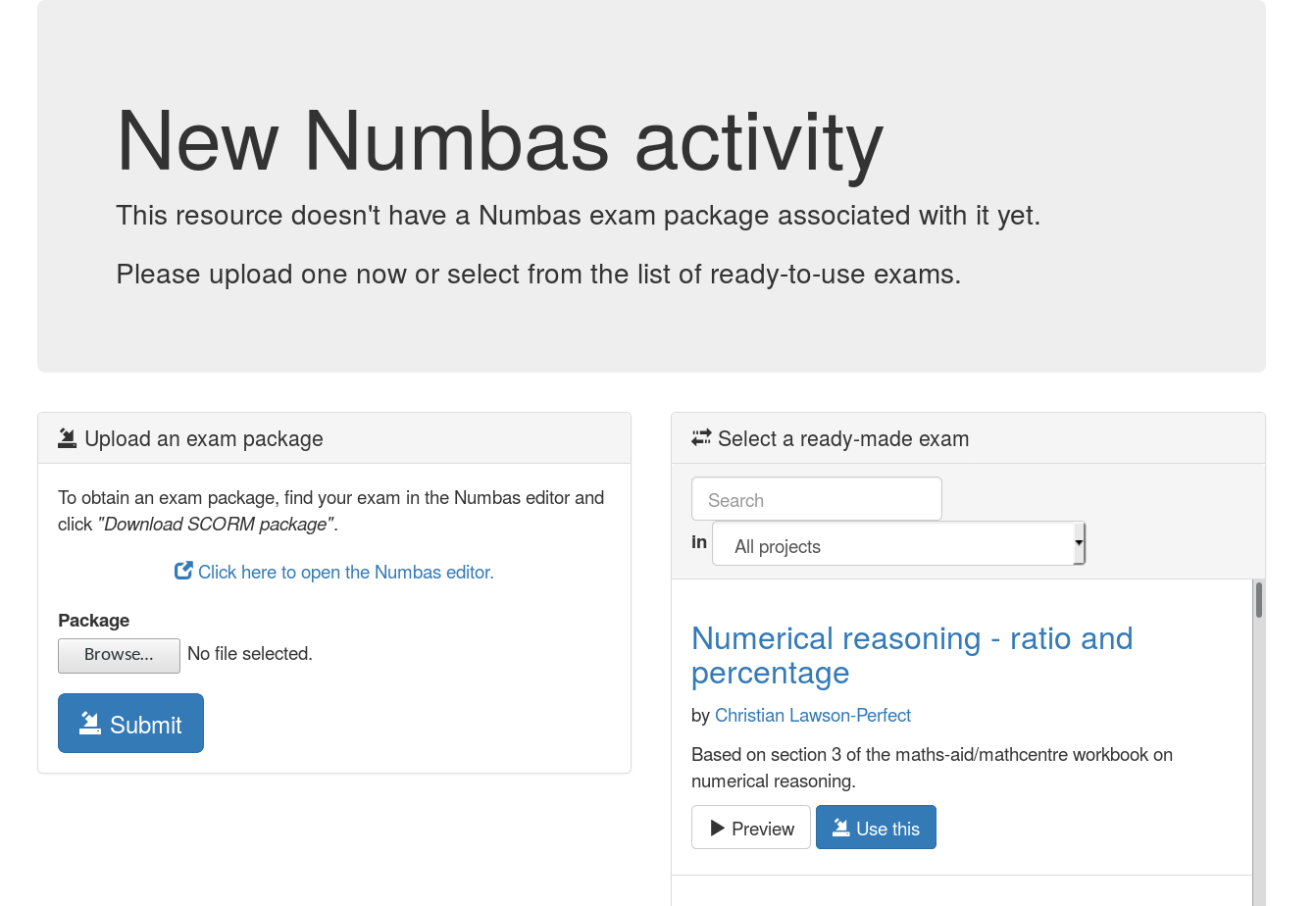
The first thing you see on creating a new Numbas resource.
Either upload an exam package that you have downloaded from the Numbas editor or, if any editor links have been created, select an exam from the list.
When you download an exam package from the Numbas editor, you must use the SCORM package option.
Once you’ve selected an exam, you will be shown the dashboard for the resource.
Dashboard

The dashboard screen.
When you open a resource as an instructor, you are first shown the dashboard. This view offers a few actions to do with the resource, and the navigation bar at the top has links to other views.
Report scores back to VLE
The LTI provider can automatically report scores back to the VLE.
Click the Report scores back to VLE button to begin this process. This may take some time; you’ll be shown either a success message or any errors encountered while reporting scores.
This isn’t supported by every VLE.
Discount question parts
Discounting a question part removes it from the score calculations: any marks students have earned for that part are discounted.
You might want to do this if an error is found in a question.
To discount a part, click on the Discount a question part button on the dashboard.
You are shown a list of all the question parts in the exam. Click a Discount this part button next to a part to discount it. You can choose whether to remove the part from the total available for the exam, or to award everyone full marks for the part. These have different effects on the weighting of other parts in the exam - removing a part from the total will increase the weighting of other parts, while awarding full marks will increase everyone’s total score. Think carefully about what you want to do.
If you discount a gapfill part, all of its gaps are discounted. If you discount an individual gap, the other gaps are unaffected.
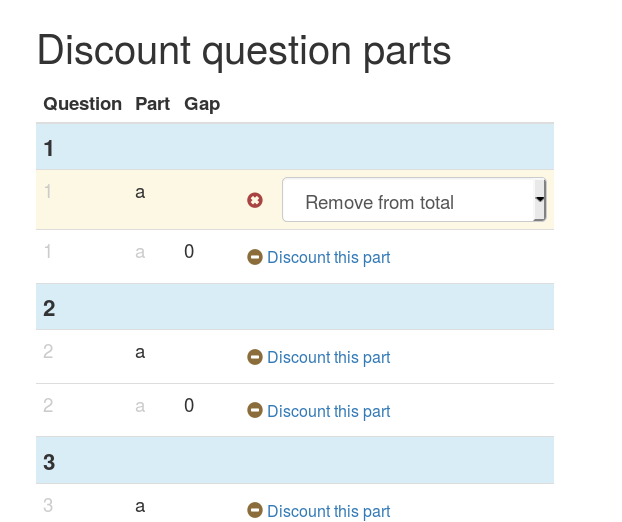
Discounting a question part.
Download scores as CSV
Click this button to download a .csv file containing the scores for each student who has attempt the resource.
The columns of the file are:
First name
Last name
Email address
Username
Percentage score
The values in the name, email address and username fields come from the VLE.
The username field might not correspond exactly to the student’s username on the VLE; in particular, Blackboard preprends usernames with cuid:.
Student progress
From the dashboard, click View individual student progress and grant access tokens to view the Student progress table.
The Student progress table lists the names of students who have attempted the activity, along with their scores as calculated following the grading method, and the number of attempts they have made.
You can narrow down the displayed list by entering a name in the Search for a student box.
Note that only students who have launched the activity are listed - the LTI provider has no way of knowing about students who have access to the activity through the VLE but have never launched it.
Access tokens
When the number of attempts students are allowed to make is limited, circumstances can arise in which you want to allow particular students another attempt.
To do this, click the plus symbol in the Access tokens column next to the student’s name in the Student progress table.
To revoke an access token, click the minus symbol next to the student’s name in the Access tokens column. Attempts started with an access token that is subsequently removed will not be deleted.
When the student launches the activity, they will be offered the opportunity to start a new attempt.
Validate a receipt code
If enabled (see Email attempt receipts to students on completion?), students are emailed a receipt on completion of an attempt. The receipt contains information about their attempt, such as time and score, as well as a code that you can use to confirm that a receipt is valid.
On the Validate a receipt code page, copy a code from a student into a box.
If the code is valid, you’ll be shown the information from the receipt, as well as a link to view the attempt’s data in more detail.
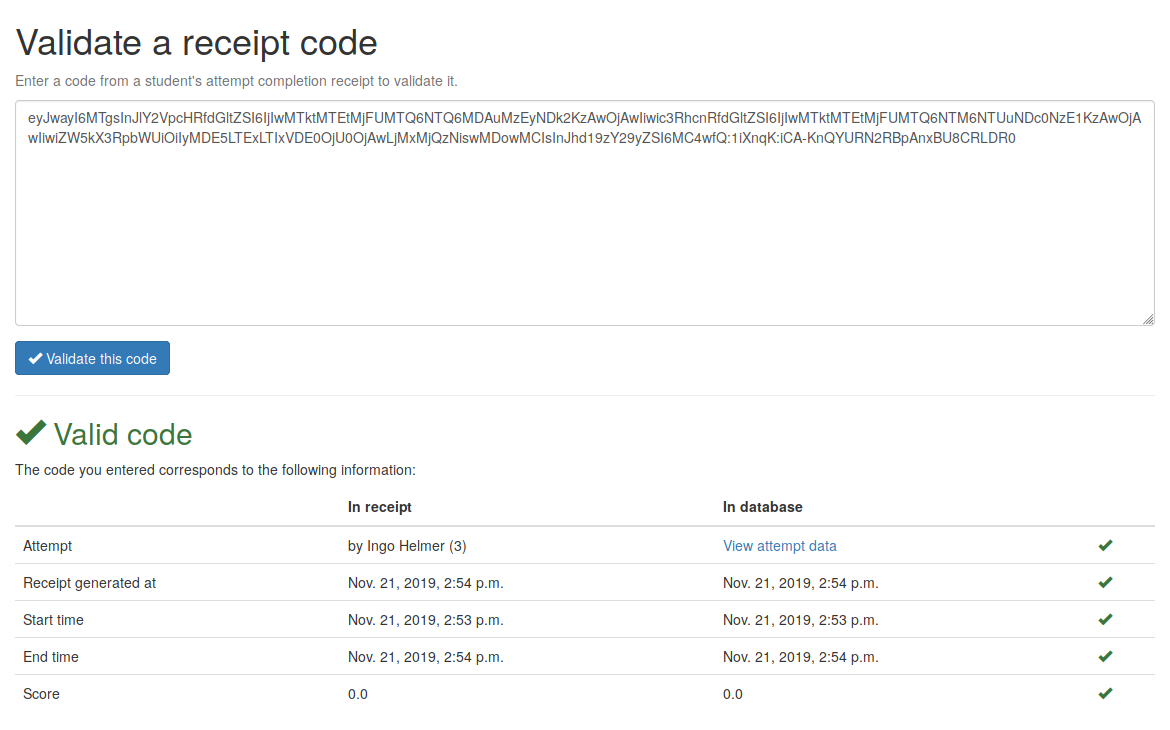
A validated receipt code.
If the code is invalid, or corresponds to an attempt at a different resource, you’ll be told so.
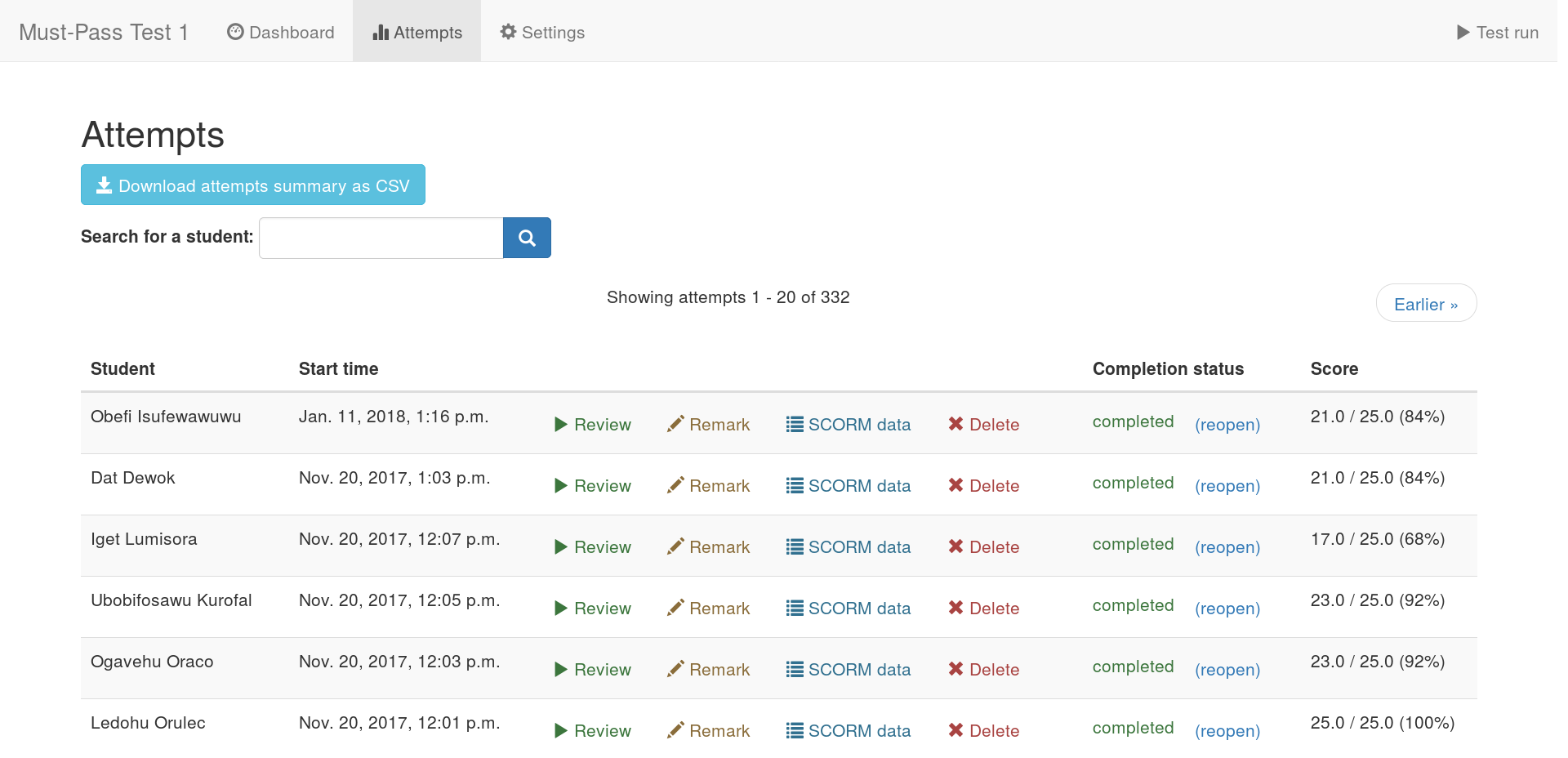
An invalid receipt code.
Attempts
Click on the Attempts button at the top of the page to view the attempt management screen.

The attempt management screen.
Download attempts summary as CSV
Click the Download attempts summary as CSV button to obtain a .csv file with information on every attempt at this activity.
The columns of the file are:
First name
Last name
Email address
Username
Start time, in
YYYY-MM-DD HH:MM:SS.ffffff+HH:MMformat.Completed? (Either
completedorincomplete)Total score
Percentage (total score as a percentage of marks available)
One column giving the total score for each question
Download all attempt data as JSON
Click the Download all attempt data as JSON button to obtain a .json file containing all data to do with attempts on this resource, including part and question scores, all SCORM data, completion status, and the values of question variables.
Review an attempt
Click the Review button to view a student’s attempt as they saw it.
This is useful when a student queries the mark they were awarded for a part of the exam.
Note that review mode always opens attempts as if they were completed, even if the student has not yet ended the exam.
Remark an attempt
Click the Remark button to manually change the score awarded for a question part.
You are shown a list of every question part in the exam. Click the pencil icon on the row corresponding to the part you want to change, and enter the new score. The new score is saved as you type, and the totals for the question and the whole exam are recalculated automatically.

Remarking an attempt.
Note
After updating the exam package associated with a resource, you can automatically remark all attempts using the Remark tab.
Data
By clicking on the Data button, you can see a timeline describing actions the student took during their attempt.
Items shown include moving between questions, submitting answers, and marks awarded. This page will update in real-time as the student continues their attempt.
Click the Download attempt data in JSON format button to obtain a .json file containing all data pertaining to this attempt, including question and part scores, completion status, and the values of question variables.
Numbas uses the SCORM standard to store data about attempts. By clicking on the View raw SCORM data for this attempt button, you can see all of the SCORM data model elements stored for a particular attempt.
This is most useful for debugging connection errors, to confirm that data has been saved.
If Most recent value only is ticked, only the most recent value for each element is shown. Untick it to see every value that the element has taken since the start of the attempt.
You can type a regular expression in the Search for an element box to narrow down the displayed list of elements.
Delete an attempt
Click the Delete button to delete an attempt. This is permanent; the student will be able to start a new attempt next time they launch the activity.
Reopen an attempt
Sometimes students accidentally close their attempts before they mean to. Click the Reopen button to allow a student to complete their attempt. The next time that they launch the activity, they will be able to resume the attempt as if they had only paused it.
Beware that the standard Numbas settings allow a student to see the correct answers to every question once they have finished their attempt. If you’re concerned about this, it’s often better to make the student start a new attempt, rather than reopen the previous one.
Settings

The resource settings screen.
Replace exam package
If you discover an error in your exam, you can update it by downloading it again from the editor and clicking the Replace exam package button.
Any new attempts will use the latest version of the exam package. Because the new version might have changed in a way that is incompatible with existing attempts, for example by removing or rearranging question parts, any attempts started with the old package will by default continue to use the old package. If you know that the new package is compatible with the old one, for example if you’ve just corrected some text or fixed a bug in some code rather than changing the structure of the exam, tick This is a safe replacement for the previous exam package. All attempts using the old package will be updated to use the new one.
If the new version of the exam fixes problems with marking, you can try automatically remarking existing attempts.
Grading method
Specify how a student’s score for the activity is calculated.
“Highest score” will use the highest total score from any of the student’s attempts.
“Last attempt” will use the total score from the attempt which the student began last.
Include incomplete attempts in grading?
If ticked, incomplete attempts will be included when calculating the student’s score for the activity.
It’s normally good to leave this on, so that students who forget to click the End Exam button won’t be penalised.
Maximum attempts per user
How many attempts at the resource can each user take?
If set to 0, then there is no limit.
You can grant extra attempts to individual students with access tokens.
When to show scores to students
When a student reopens an activity, they are shown a summary of their attempts. You might not want to immediately show students their scores on this screen.
“Always” means the student will see scores for all attempts, including incomplete attempts.
“When attempt is complete” means the student will only see their score for an attempt once it is complete.
“When review is allowed” means the student will only see their score after the date specified in the Allow students to review attempts from setting.
“Never” means that no scores are shown to the student, even after they’ve completed their attempt.
Warning
This only controls the display of scores by the LTI provider. If you want to hide scores from the students, you must also turn off the score feedback options in the exam editor.
When to report scores back
Specify when students’ scores are reported back to the consumer. Some VLEs make reported scores available to students immediately, which you may not want.
“Immediately” - scores are reported as soon as they change, i.e. whenever a student submits an answer.
“On completion” - a student’s score is reported when they complete an attempt.
“Manually, by instructor” - Scores are only reported when an instructor clicks the Report scores back to VLE button on the dashboard.
Allow students to review attempts from
Specify when students are allowed to re-enter completed attempts in review mode.
If left blank, students can review their attempts at any time.
If a date and time are set, students may only review their attempts after that time.
Instructors may always review students’ attempts, from the Attempts tab.
Available from and available until
Specify when students are allowed to access the resource.
You can set none, one or both of the options Available from and Available until.
If Available from is before Available until, the resource will be available only between those two times. Use this for a resource which should only be available for a certain period, such as an exam.
If Available from is after Available until, the resource will be unavailable between those two times, but available any time before Available until and any time after Available from. Use this for a resource which should be made unavailable for a certain period, such as a bank of practice material which students should not have access to during a summative assessment period.
Any students who have the resource open when it becomes unavailable will be forced to quit.
Email attempt receipts to students on completion?
If ticked, then when a student completes an attempt at this resource they will be emailed a receipt summarising their attempt.
The receipt contains a code which instructors can use to confirm the receipt’s contents. See Validate a receipt code.
Remark
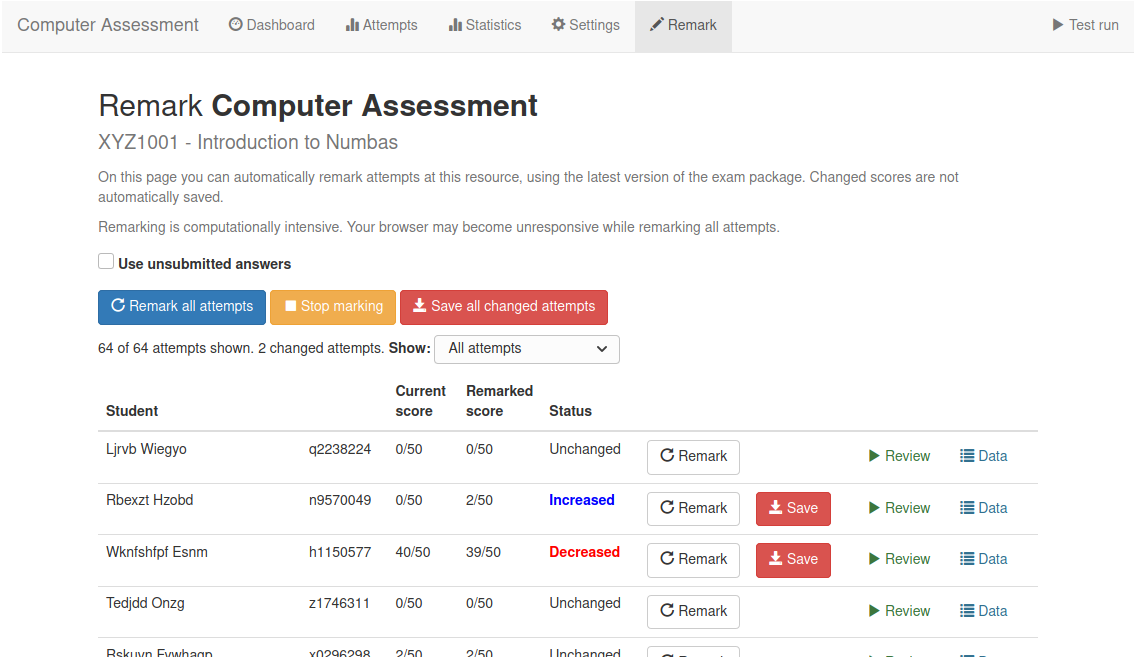
Remarking a resource.
The Remark tab provides an interface for automatically re-running attempts at the resource using the latest version of the exam package. If the total score awarded for an attempt is different to the saved score, you can overwrite it.
When the page loads, you are shown all attempts at the resource. You can remark individual attempts, or remark all the attempts automatically.
Note
Remarking an exam is computationally intensive, so your browser may appear unresponsive.
If Use unsubmitted answers is ticked, then any answers entered by the student but not submitted will be considered to be submitted. You can use this in cases where a student forgot to submit their answers and you want to have them marked anyway.
After you click Remark all attempts, each attempt will be remarked in turn. A progress bar shows the proportion of attempts that have been remarked, and an estimated time until completion.
To stop the process of remarking all attempts, click Stop marking. If an attempt is currently being remarked, it can’t be interrupted - the process will stop after that attempt is finished.
You can choose to Show all attempts, only attempts with changed scores, or only attempts with either increased or decreased scores.
When one or more attempts have been remarked and produced different scores, the Save all changed attempts button becomes available. After clicking this button, any changed data corresponding to the shown attempts is saved to the database. This data will appear in the timeline for the attempt and will affect the reported scores for the attempt.
Each attempt has its own Remark button, which will remark only that attempt. When an attempt has been remarked, the change in total score is shown. If the total score is different to that stored in the database, a Save button appears. Clicking the button causes changed data corresponding to the attempt to be saved to the database, updating its timeline and reported score.
Access changes
Access changes are a means of changing deadlines or allowing a different number of attempts at the resource to certain students.
Each access change applies to a list of students.
To create an access change, click on the Access changes tab, then Add an access change.
There are several fields that you can modify. Leave a field entirely blank to keep the standard value from the resource’s settings.
In the Description field, describe what the access change is for and who it applies to, such as “25% extra time”, or “Late submission for Elliot D”.
Access changes take effect immediately. Any students who are completing an attempt at the time that their access changes will receive the new details immediately. If the resource becomes unavailable for them, the attempt will end immediately. Otherwise, a message will appear on their screen describing the new deadline.
Availability dates
The fields in the Availability dates section change the time period in which the affected students can complete attempts at the resource. You can either set new fixed start and end dates, or fill in the Extend the deadline by field to extend the resource’s normal Available from date.
If several access changes apply to a student, the changes from the last created access change are used.
Exam duration
If the exam associated with the resource has a duration set, then you can extend it, either by an absolute length of time or by a percentage of the standard duration.
If several access changes apply to a student, the change in the last created access change is used.
Number of attempts
The Maximum attempts per user field overrides the resource’s Maximum attempts per user field.
The student is allowed whichever is the greatest of the resource’s normal maximum number of attempts and the numbers specified by any access changes affecting the student.
A value of zero in this field does not mean “no change”, it means that the affected students are allowed to start as many attempts as they like.
Applies to
Specify which students the access change applies to by giving lists of usernames or email addresses. These are compared with the usernames and email addresses sent by the LTI consumer.
Warning
Note that the LTI consumer can choose what it send for these fields, so they might not match the values you use in other systems. The access change form shows the username and email address it received from the LTI consumer for your account, as a guide.
Test run
Click the Test run button to launch the Numbas exam. Data will not be saved - this feature is solely a convenience for instructors to check the contents of the exam.